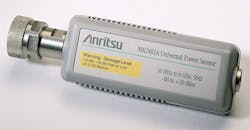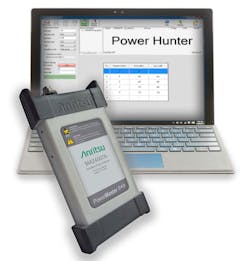This file type includes high resolution graphics and schematics when applicable.
Engineers select power sensors based on their specific application and how the various sensor designs—thermal or diode—fit their measurement needs. That evaluation process is changing as more designs utilize higher frequencies due to RF spectrum overcrowding, high-bandwidth services, 5G backhaul, IEEE 802.11ad, WirelessHD, and other technologies.
To understand where power sensor trends are going, it is important to realize the pros and cons of each sensor type. A thermocouple sensor has a very good linear relationship between the changes in voltage and power, making it possible to achieve highly accurate power readings. Another benefit is that the thermocouple elements typically have a good resistance to electrostatic discharge (ESD) or other transient burnout. Finally, thermocouple detectors measure root-mean-square (RMS) power and are therefore modulation-independent. They will provide accurate average power readings of almost any signal type.
These accurate readings come with some drawbacks—chief among them, much slower measurement speeds. They also have rise times in the millisecond range, so they are not suitable for measuring peak or pulse power. Thermocouple sensors also have a higher noise floor, which limits the dynamic range to only around −30 or −35 dBm to +20 dBm in typical implementations.
Engineers who need to make true-RMS measurements across a wider dynamic range often select diode sensors (Fig. 1). The measurement speed of diode sensors is limited by their ability to process the data. With today’s sensors having better processing technologies, diode sensors now feature measurement speeds in the thousands and tens of thousands of readings per second. They typically can measure power down to −40 or −50 dBm.
Radio Receivers
To measure signals of lower power, many engineers will use radio receivers (mostly in spectrum analyzers), which have much lower noise compared to thermal or diode sensors. These receivers can have noise floors well below −100 dBm, so engineers will be able to find and measure many signals that would never register on a thermal or diode sensor.
The major disadvantage is a high price tag. Most radio receivers are only available in spectrum analyzers, so they are usually restricted to the lab, which adds to the budget, and a wider breadth of measurements is required. Radio receivers also will not have the same amplitude accuracy as traditional power meters, generally achieving around ±2 dB.
Just as the rollout of LTE and increasing use of modulated signals factored in the power sensor’s evolution, so will current designs at higher frequencies. At millimeter-wave bands, power tends to fade due to propagation and transmission losses. For most current power sensors, conducting accurate power measurements at these higher frequencies and lower power levels are problematic.
Being able to measure power down to a level such as −90 dBm will result in greater product/system performance verification of high-frequency devices in production environments. For example, chipmakers will verify designs during research and development using a radio receiver or spectrum analyzer to obtain measurements down to −100 dBm. These instruments are too costly to use during manufacturing, which means power sensors measuring down to −40 dBm maximum are used. New cost-effective solutions are being developed that can measure power down to −90 dBm while conducting the necessary on/off measurements associated with manufacturing.
Frequency Selectability
When it comes to field testing, power sensors that are not frequency-dependent and have limited dynamic range are not as effective, owing to the overcrowded RF spectrum where unintended signals such as spurs, harmonics, and interference can impact power readings. Power sensors that let users zero in on their signal of interest enable measurements such as channel power, adjacent channel power (ACP), and spur/harmonic suppression to be conducted with greater efficiency and confidence.
One example of this new wave of instrument is the MA24507A Power Master millimeter-wave power analyzer from Anritsu (Fig. 2). Utilizing Anritsu’s ShockLine nonlinear-transmission-line (NLTL) technology, this USB-powered, frequency-selectable RF power sensor combines a power measurement range of −100 to +10 dBm with fast measurement speeds in a compact, lightweight housing.
Unlike thermal and diode-based sensors, Power Master also gives users the ability to define the frequency of the signal to measure. For example, when field testing signal strength for wireless backhaul networks, a diode or thermal power sensor will not differentiate the intended RF signal from the other signals present at the input, which could potentially spoil the measurement.
With Power Master, a field technician can define the frequency channel in which to measure power, focusing on the signals of interest or identifying specific interference in nearby channels. In the lab, an engineer verifying RF circuit designs can use Power Master to troubleshoot unexpected signal behavior caused by a dirty local oscillator (LO), bad components, or outside signal interference. With the ability to measure power below −90 dBm, Power Master enables more over-the-air (OTA) testing that would otherwise be difficult to do with a bulky spectrum analyzer or power meter with limited power range.
Conclusion
The ability to conduct power measurements will become increasingly important as more designs climb to high frequencies to accommodate bandwidth. To address many of these applications—including millimeter-wave designs, IEEE 802.11ad, WirelessHD, and 5G backhaul—power sensors will need to be able to efficiently conduct the necessary tests at lower power levels. New design architectures will continue to be developed to meet these needs.
Russel Lindsay, Product Marketing Engineer
This file type includes high resolution graphics and schematics when applicable.




